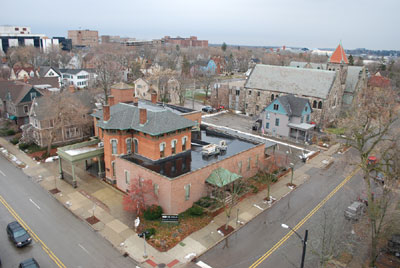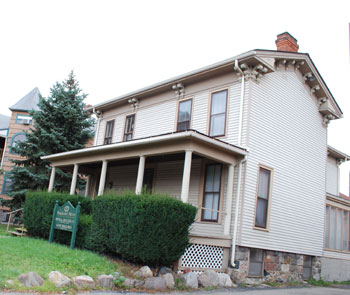The State Street Historic District, glamorous on a damp evening. [photo]
Stories indexed with the term ‘historic district’
Washington & Second
Former road commission building at 415 W. Washington now bears sign reading “Renovation Yes, Demolition No!” Context is that Ann Arbor city council work session on March 25 included mention that the more likely outcome for the now vacant city-owned building is demolition. [photo] A nice shot of the whole facade from several years ago by Jim Rees: [Flickr]
Chapter Added to Fifth Ave. Historic Saga
Ann Arbor city council meeting (Oct. 24, 2011): Monday’s meeting was added to the council’s calendar specifically for the purpose of taking a second and final vote on the Heritage Row planned unit development (PUD). The project would have rehabbed or reconstructed a row of seven existing houses on Fifth Avenue, south of William Street, and built three new apartment buildings behind them.

In the foreground is Carsten Hohnke (Ward 5) as his council colleague Mike Anglin (Ward 5) explained the reasons why he wanted to appoint a historic district study committee for the area south of William Street along Fourth and Fifth avenues.
Heritage Row had been considered and rejected more than once before by the council, with a history in front of Ann Arbor’s legislative body dating back well over a year. The project had been brought back for reconsideration because the demolition of the seven houses was apparently imminent – as part of the construction of City Place. City Place is a different, already-approved project on the same Fifth Avenue site by the same developer.
But by the Friday before Monday’s meeting, all four agenda items related to Heritage Row (site plan, zoning ordinance and their respective public hearings) had been deleted from the agenda. The developer had withdrawn the Heritage Row project.
With the construction of City Place a virtual certainty – along with demolition of the houses – on Monday afternoon Mike Anglin (Ward 5) placed a proposal on the agenda that would have started a procedure to establish a historic district in the area. The related moratorium on demolition in the study area would have, at least temporarily, blocked the City Place development.
But in the end, the council was in no mood to repeat the same exercise it had gone through two years ago. At that time, the council had appointed a historic district study committee, then subsequently rejected the committee’s recommendation that a historic district be established in the neighborhood. Arguing against the establishment of a historic district study committee this time around, Tony Derezinski (Ward 2) said he didn’t want the council to become a joke. Later during deliberations Margie Teall (Ward 4) ventured that already, “We’ve become a bit of a joke.”
Also on Monday afternoon, two other items – which asked the council to reconsider votes it had taken at the Oct. 17 meeting about the City Place project – were placed on the agenda by Stephen Kunselman (Ward 3). Kunselman was not interested in getting the votes reversed, but had questions he wanted answered. While other councilmembers agreed to reconsider the items, the council then dispatched them with unanimous votes after Kunselman’s questions.
That left one item on the agenda – added on Friday after the agenda’s Wednesday publication – that actually resulted in a vote that might change the course of events in the city. The resolution directed city staff to make recommendations on improvements to crosswalks throughout the city. Councilmembers expressed some interest in tweaking a new pedestrian ordinance that it approved on July 19, 2010.
Also at the meeting, the council went into closed session to discuss the city attorney’s performance evaluation. It resulted in no change to city attorney Stephen Postema’s salary, but allowed him to cash out 250 hours of accrued time before Dec. 31, 2011. [Full Story]
Residential Site Plan for Former Bindery OK’d
At its April 19, 2011 meeting, the Ann Arbor city council unanimously approved a site plan for 215 N. Fifth Ave. – formerly the site of the Bessenberg Bindery, which has moved to the Thomson-Shore Inc. facility in Dexter. The Fifth Avenue property is now owned by Jon and Lisa Rye. Jon Rye, a University of Michigan alumnus, is president and chairman of Greenfield Partners and Greenfield Commercial Credit, both located in Bloomfield Hills.
The plan calls for tearing down the one-story building and constructing a two-story, single-family, owner-occupied house with an attached two-car garage. The entrance will be oriented to the north, and the garage will be accessed from the public alley on the west side of the site. The site is directly north of the Armory condos and south of a two-story residential rental property.
The project requires a site plan because the single-family house is on property that’s not zoned solely for residential purposes. It’s zoned D2 (downtown interface) and is located in the Old Fourth Ward Historic District. The Ann Arbor historic district commission already reviewed the site plan and issued a certificate of appropriateness at its Feb. 10, 2011 meeting. The Ann Arbor city planning commission had given its recommendation for approval of the site plan at its March 15, 2011 meeting.
This brief was filed from the city council’s chambers on the second floor of city hall, located at 301 E. Huron St. A more detailed report will follow: [link] [Full Story]
House Plan OK’d at Former Bindery Site
The Ann Arbor planning commission, at its March 15, 2011 meeting, unanimously recommended approval of a site plan for a single-family house at 215 N. Fifth Ave. – formerly the site of the Bessenberg Bindery, which has moved to the Thomson-Shore Inc. facility in Dexter. The plan calls for tearing down the building and constructing a two-story, single-family, owner-occupied house with an attached two-car garage. The garage will be accessed from the public alley on the west side of the site. Architect Dick Mitchell was on hand to describe the design.
The project requires a site plan because the single-family house is on property that’s not zoned solely for residential purposes. It’s zoned D2 (downtown interface) and is located in the Old Fourth Ward Historic District. The Ann Arbor Historic District Commission has already reviewed the site plan and issued a certificate of appropriateness at its Feb. 10, 2011 meeting. The project will next be voted on by city council for final approval.
This brief was filed from the boardroom in the Washtenaw County administration building, where the planning commission is meeting due to renovations in the city hall building. A more detailed report will follow. [Full Story]
Unscripted: Historic District, Immigration
Ann Arbor City Council meeting (July 6, 2010) Part 1: At its Tuesday night meeting, the city council rejected a recommendation to establish a historic district on Fourth and Fifth avenues south of William Street and north of Packard. The absence at the meeting of Mike Anglin (Ward 5), who was expected to support the district, did not have an impact on the outcome of the 4-6 vote.

Sabra Briere (Ward 1) and Carsten Hohnke (Ward 5) confer during a brief break at the city council meeting. After the break, Hohnke withdrew his motion that would have asked the council to consider the Heritage Row project for a third time in total, and for the second time at their July 6 meeting. (Photos by the writer.)
Rejection of the district then set off a series of parliamentary procedures by the council. The actions were prompted by concern that without the protection afforded by the historic district, seven houses would be demolished through construction of an already-approved matter-of-right project (MOR), City Place.
So the council brought back for reconsideration a different project on the same site – Heritage Row, which the council had rejected at its previous meeting. A key feature of the Heritage Row project, which includes three new apartment buildings, is that it would also retain the seven houses.
The vote on the reconsideration of Heritage Row failed. That resulted in an attempt by Carsten Hohnke (Ward 5) to have the council reconsider the historic district, which the council had just rejected. Hohnke’s council colleagues weren’t interested in revisiting the issue.
So Hohnke then began the parliamentary procedure to reconsider the Heritage Row project – for the second time that evening and for the third time total. The move required another rule suspension – this one concerning the number of times a question could be considered.
After a brief recess, however – during which Hohnke was apparently persuaded that developer Alex de Parry would not actually follow through and build the City Place MOR project – Hohnke withdrew his motion. A comment from Ann Arbor resident Ethel Potts, who attended the council meeting and who has witnessed more than four decades of city politics, summarized the sentiments of many in the audience: “As weird goes, this was pretty weird.”
A moratorium on demolition, which covers the area considered by the historic district study committee, will remain in place through Aug. 6. The council meets on Aug. 5, after the primary elections on Aug. 3.
In other business, the city council approved a resolution opposing legislation recently enacted by the state of Arizona that requires local law enforcement officials to investigate a person’s immigration status, when there is a reasonable suspicion that the person is in the U.S. unlawfully.
The council transacted a range of other business and communications as well. Those issues are covered in Part 2 of the July 6 meeting report. Part 1 focuses on the Arizona immigration law and the historic district. [Full Story]
Zingerman’s Project Seeks Brownfield Status
The major renovation and expansion in the works for Zingerman’s Deli cleared its most recent major hurdle in May, gaining site plan approval from the Ann Arbor planning commission. While the site plan now moves on to city council, the business is taking action on another front as well: Applying for support from the local and state brownfield program.

Grace Singleton, a managing partner with Zingerman's Deli, talks about plans to apply to the local and state brownfield program as part of the deli's renovation plans. The business hosted a public meeting about the plans on June 21. (Photos by the writer.)
On June 21, Zingerman’s hosted a public meeting to answer questions about their plans for the brownfield application. Matt Naud, the city’s environmental coordinator, was on hand as well, and distinguished between this project and those that are typically associated with the term “brownfield.” In the case of Zingerman’s Deli, “it’s economic development,” he said, “It’s not about environmental cleanup.”
Specifically, brownfield status would allow Zingerman’s to be eligible for tax increment financing (TIF), a mechanism that would let the business recoup certain qualified expenses related to the project – possibly as much as $817,000 over 15 years.
It’s a different approach than the brownfield application most recently approved by city council for the Near North affordable housing project on North Main. In that case, the site’s need for environmental cleanup qualifies it for a brownfield status. Zingerman’s application also differs from Near North’s in that Near North isn’t seeking reimbursement through TIF. Both projects plan to apply for Michigan Business Tax credits. [Full Story]
The Constitution of Historic Districts
At a recent forum hosted by the Ann Arbor city Democratic party for candidates of the 52nd and 53rd District state House races, the topic of the state’s constitution arose in the form of an audience question. Did the candidates favor holding a convention to rework the state’s document of basic law?
The state’s constitution also came up in a recent letter conveyed to the city of Ann Arbor by an attorney for Alex de Parry, the developer of a proposed project called Heritage Row along Fifth Avenue south of William Street. The project was voted down at the Ann Arbor city council’s June 21 meeting on a 7-4 vote in favor, thus failing to meet the eight-vote majority required. [Chronicle coverage of that meeting is forthcoming.]
The main focus of the letter, sent to the city by de Parry’s legal counsel the same day as the council met to vote on Heritage Row, is not that project per se, but rather the historic district that the council may decide to establish at its next meeting on July 6. The recommended historic district, which includes the parcels that were to be used to build Heritage Row, received its initial consideration by the council at their June 21 meeting.
While its more customary for councilmembers to vote for a proposal at its first reading, even if they’re against it, three councilmembers at the June 21 meeting chose to oppose the establishment of the district already at its first reading. Tony Derezinski (Ward 2), Stephen Rapundalo (Ward 2) and Marcia Higgins (Ward 2 Ward 4) all voted against the historic district.
None of the three cited the specific issues raised in the letter from de Parry’s legal counsel as reasons for voting against the district – Derezinski had voted at the council’s Aug. 6, 2009 meeting against establishing a committee to study the question. And Rapundalo had supported a postponement of that vote.
But for the final vote on July 6, the points raised in the letter from de Parry’s legal counsel may well factor explicitly into the council’s deliberations. The legal reasoning in the letter leads to the conclusion that the way local historic districts are set up in Michigan potentially violates the state’s constitution. And if the reasoning in the letter stands legal scrutiny, it could change the way any future historic districts in the state of Michigan are established. [Full Story]
Heritage Row Likely to Need Super-Majority
Ann Arbor City Council meeting (June 7, 2010): Speculation that the vote on the Heritage Row project would be delayed was borne out on Monday night. Without discussion, the council postponed votes on the development’s rezoning and site plan until June 21.
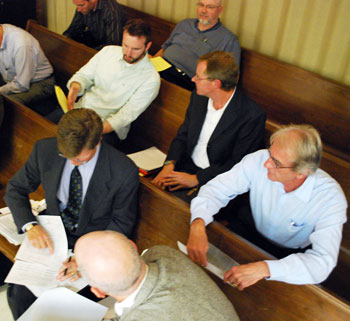
Left in the frame, scanning through the protest petition documents, is Scott Munzel, legal counsel for Alex de Parry, developer of the Heritage Row project. De Parry is seated in the row behind with his arms resting on the bench back. In the foreground is Bradley Moore, architect for Heritage Row. (Photos by the writer.)
Councilmembers were also informed that a protest petition had been filed on Heritage Row Monday afternoon, which – once validated – would bump the requirement for approval from a simple six-vote majority to eight out of 11 council votes. Petition filers have calculated that they’ve collected signatures from 51% of adjoining property owners, weighted by land area. That exceeds the 20% required for a successful petition, but as of late Wednesday, the city had not completed its verification process for the signatures. [Update: Early Thursday afternoon, the city confirmed the 20% threshold had been met.]
In other business, the council approved increases in water and sewer rates and gave initial approval to changes in the city code language on the placement of recycling carts.
A wording change in the list of permissible uses for public land was also given initial approval, but not without discussion. Thematically related to land use was a presentation during the meeting’s concluding public commentary in response to a request for proposals (RFP) for the privatization of the city-owned Huron Hills golf course.
Also receiving discussion was an item pulled out of the consent agenda that authorized $75,000 for Ann Arbor SPARK, for economic development.
Criticism during public commentary on the appointment and nomination process used by the mayor to fill seats on boards and commissions stirred mayor John Hieftje to defend shielding individual members of those bodies from public demands.
Public commentary also elicited from Stephen Rapundalo (Ward 1) an update on the development of the Library Lot – he chairs the committee charged with overseeing the RFP process. [Full Story]
Zingerman’s: Making It Right for the HDC
Employees at Zingerman’s Deli – or any of the Zingerman’s family of businesses – are trained to handle complaints from customers with a five-step process. The third step: Make it right.
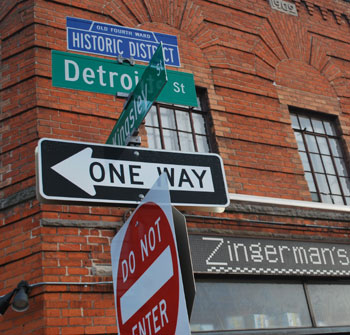
Plans to build an addition behind the brick Zingerman’s Deli building will ultimately require approval from the city’s historic district commission. (Photos by the writer.)
Zingerman’s itself is “handling a complaint” from the city’s Historic District Commission (HDC) – one that can be traced back to a June 2008 Zingerman’s request to demolish two houses, which are located in the city’s Old Fourth Ward historic district.
Now Zingerman’s is bringing back another proposal, but this time they’re not starting formally with the HDC. Instead, they’ll begin by seeking approvals from the city’s planning commission and the city council.
The site plan calls for a two-story, 9,500-square-foot structure to be added to the rear of the deli building, which will carry a price tag of around $4 million. The new building would replace the house at 322 E. Kingsley St. and extend lengthwise towards Community High School.
Zingerman’s started satisfying the formal steps for getting approval of their expansion project this week, on Monday, March 8, by holding a citizens participation meeting.
But Zingerman’s has also met informally with the HDC at two separate work sessions since the start of the year – one in January and the other on Thursday, March 11. Based on a significant change in design between those two meetings, which integrates “the orange house” into the project instead of demolishing it, Zingerman’s is trying to “make it right” for the HDC.
Still, at Thursday’s HDC work session, the Zingerman’s team stressed how great the challenges were – financial and logistical – to preserving the orange house as part of the project design. It seemed apparent that Zingerman’s was making an implicit pitch for members of the HDC to give a green light for the previously proposed project – the one minus both houses. [Full Story]
Heritage Row Gets Postponed
Ann Arbor Planning Commission meeting (Feb. 18, 2010): After a public hearing on the latest iteration of a controversial South Fifth Avenue housing project, planning commissioners voted to postpone action on a project now called Heritage Row.
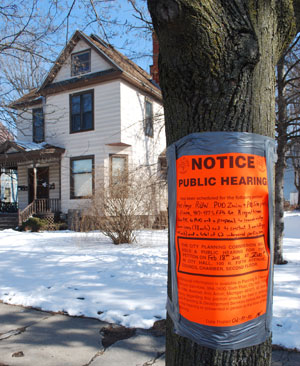
A public hearing notice duct-taped to a tree on Fifth Avenue, announcing the Feb. 18 public hearing of the proposed Heritage Row development. (Photos by the writer.)
Developer Alex de Parry is asking to rezone the seven-parcel site, with plans to restore the historic houses there and build three 3.5-story buildings behind them. Commissioners generally were favorable toward the project, citing benefits of restoring the older homes, among other things. A fair amount of their discussion involved what color of brick to use on those new buildings.
The public hearing drew several neighbors who raised concerns they’d voiced over de Parry’s previous project in the same location, called City Place. Several mentioned the new buildings as being too large for the neighborhood. Another concern: An historic district study committee hasn’t finished its report, which could affect the project.
But before they considered Heritage Row, commissioners discussed proposed changes to Plymouth Green Crossings, a mixed use complex off of Plymouth, west of Green Road. The developers, represented by David Kwan, are asking to alter their original agreement with the city.
Economic conditions, including the departure of Pfizer, have slowed plans to complete the project, which was to include a total of three buildings and a standalone restaurant. Two buildings have been constructed – tenants include Sweetwaters and Olga’s – but a perceived lack of parking has stymied attempts to fill the retail space, Kwan said. He and his partners hope to put in a temporary parking lot on the land that originally was slated for the restaurant.
One commissioner wasn’t too excited by Kwan’s idea. Concerns were also raised about payments to the city’s affordable housing fund, which are being spread out over several years. [Full Story]
Fifth Ave. Project to Meet Historic Standards
Monday evening on the third floor of the downtown Ann Arbor District Library, developer Alex de Parry gave residents and neighbors an update on a project he’s been proposing in one form or another since early 2008.

Alex de Parry describes how the rear of the existing seven homes would in some cases be modified consistent with their period of historical significance. (Photo by the writer.)
The housing development would be located on the east side of Fifth Avenue, just south of William Street.
Previously known as “City Place,” the proposal has been newly baptized as “Heritage Row.” The new nomenclature reflects in part the expressed intent of de Parry’s development team to meet the Secretary of the Interior’s standards for historic preservation for a row of seven old houses. Behind the row of houses, three new buildings would be constructed. Underground parking would be constructed under the three new buildings.
Previous versions of the project would have either demolished the seven houses or preserved them only in part. Now, the plan is to rehabilitate those houses to historic district standards. [Full Story]
From the Teeter Totter to Traverse City
[Editor's Note: HD, a.k.a. Dave Askins, editor of The Ann Arbor Chronicle, is also publisher of an online series of interviews on a teeter totter. Introductions to new Teeter Talks appear on The Chronicle.]
Longtime Ann Arbor resident Metta Lansdale was recently hired as director of the Traverse Area District Library in Traverse City. Her first day on the job is today, Nov. 2. I talked to her on the teeter totter just before her move north. [Full Story]
City Council Begins Transition
Ann Arbor City Council meeting (Sept. 8, 2009): It did not look like a lot was going to happen at Ann Arbor’s city council meeting on Tuesday.
Sandi Smith (Ward 1) indicated early in the meeting that action on the Near North development would be postponed. A speaker during public commentary noted that a controversial resolution affecting the municipal airport had been yanked from the meeting’s agenda. And Mike Anglin (Ward 5) announced a delay in his intention to bring a resolution that would make publicly available numerous city council emails dating to the early 2000s. Council did not contemplate any resolutions in connection with the Argo Dam. [The Chronicle will report separately on the work session held immediately prior to the council meeting, which focused on Argo Dam.]
But as it turned out, on Tuesday night a lot happened: Ann Arbor’s city council began a transition – to what will perhaps be a different way of doing business and to a new set of leaders. [Full Story]
Demolition Moratorium for Two-Block Area
Ann Arbor City Council meeting (Aug. 6, 2009): Two kinds of moratoria were on council’s agenda for Thursday’s meeting – which had been rescheduled to accommodate the Aug. 4 Democratic primary elections in Wards 3 and 5. The first was a moratorium on new development in districts zoned with the classification of R4C (multi-family residential) or R2A (two-family residential). The second was a moratorium on demolition, attached to the creation of a study committee for a possible historic district in a two-block area just south of William Street on Fourth and Fifth avenues.
Council voted down the more general prohibition on new development in R4C/R2A residential districts, but approved the historic district study committee with its attached moratorium on demolition. It’s a case where the vote tally alone doesn’t tell the whole story – or even an accurate one: Counter to what one might expect, Mike Anglin (Ward 5) voted against the R4C/R2A moratorium, while Leigh Greden (Ward 3) voted for it.
A third major agenda item facing council was also related to new development: the Near North planned unit development (PUD) proposed for North Main Street just south of Summit Street, which is an affordable housing project that includes the nonprofit Avalon Housing as a partner. The council voted to move Near North on to a second reading, when a final decision will be made.
But probably the most important matter considered by council on Thursday appeared on the agenda as an “introduction” by the city’s chief financial officer, Tom Crawford, who spent around a half hour telling the city council why the city’s projected financial condition is worse now than it had been when the FY 2010 budget was adopted in the spring. Crawford’s presentation was characterized during commentary from the public later in the meeting as the “first salvo in a PR campaign” for a city income tax.
A bit of breaking news from Crawford’s report: bonds for the Fifth Avenue underground parking garage were issued on Aug. 5. [Full Story]
Historic Commission: No Approval for Demolition
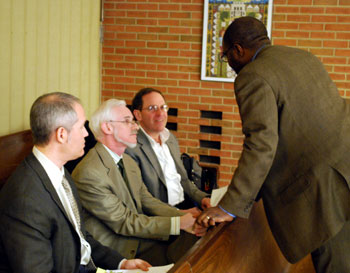
From left to right: Ron Mucha, Greg Jones, David Strosberg, Kevin McDonald (city attorney's office). Mucha and Strosberg are with Morningside LLC, while Jones, a former chair of Ann Arbor's Historic District Commission, is the architect on the parking lot.
By the conclusion of its Thursday evening meeting, Ann Arbor’s historic district commission had denied the application by Morningside LLC for permission to demolish two houses on the Old West Side.
Morningside wanted the option for demolition of the structures to give them more flexibility in the marketing of a 19,000 square foot greenhouse space adjoining the Liberty Lofts condominium project. The plan was to add additional parking spaces, if a tenant requested them.
The commission took three votes on three different motions related to the application for demolition, but was not able to pass any of them. The votes all split 3-3 among the six commissioners who attended the meeting. Given the failure to pass any of the motions, the body had fully considered the application and thus acted on it without approving it, which meant that the application failed.
What were all those motions about? [Full Story]
Demolition in Historic District?
At its Thursday meeting, Ann Arbor’s historic district commission gave approval for the demolition of a service station at Second & West Liberty streets.

The intersection of West Liberty and Second streets, looking north to south. (Image links to Microsoft's Bird's Eye View for additional detail.) The structures proposed for possible demolition are the corner service station and the two houses next door. The greenhouse space being marketed as destination retail is at the left of the frame, across the existing parking lot from the three structures proposed for demolition.
At its next meeting in March, the HDC will consider whether to give permission to proceed in demolishing two houses next door to the service station.
The permission for demolition was sought by Morningside Ann Arbor LLC, which developed the Liberty Lofts residential project in the former Eaton factory on the same block. Morningside’s reasons for seeking permission to demolish the three structures are related to another historic structure on the block: the former greenhouse space adjoining Liberty Lofts, which runs along First Street and the railroad tracks.
In order to market the former greenhouse space to retail tenants as having potential for more parking than the current 54 spaces, Morningside wants the option of expanding parking in the area where the three structures currently stand. [Full Story]
No Formal Study Committee for Germantown
Ann Arbor City Council (Dec. 15, 2008) City council heard extensive public commentary and suspended its own rules to allow for more deliberation on the topic of appointing a study committee for a new historic district possibly to be called Germantown. But in the end, the proposal garnered only one vote in addition to those of its two sponsors. In other business, council moved an anti-graffiti ordinance to a second reading (the next step for any amendment to the city code), and approved an intent to issue $9 million in bonds to fund the parking structure portion of Village Green’s City Apartments project. [Full Story]
Germantown: Study It or Not?
Ann Arbor City Council Caucus (Dec. 14, 2008) At its Sunday caucus, city council discussed two items on its agenda for Monday night:
- Historic District Study Committee – a resolution to appoint a study committee to determine the suitability of establishing a historic district called Germantown, which would include roughly the area bounded on the north by William Street, on the west by Fourth Avenue, on the south by Madison Street and on the east by Division Street.
- Graffiti Ordinance – a resolution to amend the city’s code to set forth punishments for graffiti, both for applying it and for allowing it to remain in place.
Discussion of the historic district study committee was driven by attendance at caucus of interested parties to the decision. Those parties included several residents of the neighborhood as well as a developer who has a project located inside the district of the proposed study. That project (City Place) is currently being considered by council.
No Study Committee for Old Fourth Ward
As The Chronicle previously reported, Sunday night before city council’s last meeting on Monday Oct. 20, Chris Crockett, president of the Old Fourth Ward Association, and Ray Detter, chair of the Downtown Area Citizens Advisory Council, appeared at the caucus. They were there to oppose the resolution on the following evening’s agenda to appoint a study committee to explore the question of modifying the Old Fourth Ward historic district to exclude the property at 412 E. Huron St. At caucus the question was left open as to whether the item would be left on the agenda at all, independent of how council might vote on the resolution if it stayed. [Full Story]




